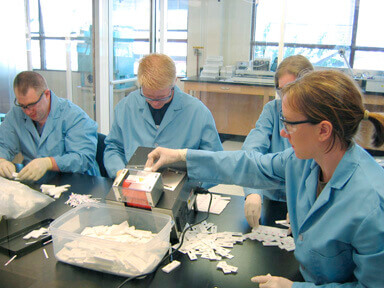Danielle DoughmanResearch!America
Danielle Doughman is Program Manager of Global Health R&D Advocacy at Research!America, a nonprofit that advocates for science, discovery, and innovation to achieve better health for all.
Research!America, a member of the GHTC, recently conducted analyses in target states to measure the health and economic impact of global health research and development (R&D), highlighting its benefits for states across the nation and strengthening the evidence base for Congress’ support of federal investments in global health R&D. Danielle Doughman, program manager for global health R&D advocacy, shares the organization’s findings in Maryland. This is the third post in a series.
If it’s true that health is wealth, Maryland has both in abundance.
Maryland is home to two federal health powerhouses, the Food and Drug Administration and the National Institutes of Health (NIH), the world’s largest medical research institute. Together, they employ 25,000 people. Silver Spring’s Walter Reed Army Institute of Research is engaged in global health research to protect our military personnel from infectious threats they may encounter in the field. And Marylanders see the direct benefits of that research: 82 percent recognize that American civilians benefit from the health research conducted by the military, according to a poll commissioned by Research!America.

What’s more, Maryland’s life sciences sector supported 71,600 jobs in 2010. Workers in the life sciences industry earned, on average, more than $91,000 annually—76 percent more than the state average. Of the nearly $52.7 million in extramural funding that flowed to Maryland from NIH in fiscal year 2012, over 70 percent, or $37.8 million, was awarded through contracts and grants to Johns Hopkins University. Hopkins is among Maryland’s largest employers, with 47,000 employees across the university and affiliated health system, and it contributes more than $10 billion per year to the state’s economy.
Nonprofit global health “product development partnerships” use a unique business model to work across sectors to accelerate the creation of low-cost drugs, vaccines, and diagnostics to advance health for the most vulnerable populations. Two such nonprofits are headquartered in Maryland.
Rockville’s Aeras, another GHTC member, engages in the development of new tuberculosis (TB) vaccines and other prevention technologies, capitalizing on the expertise of its partners to accelerate the development of the six vaccines in its R&D pipeline. Aeras’ 135 Maryland-based employees understand that the sooner effective products are available, the closer we are to dramatically reducing the 1.4 million lives lost to TB every year.
Just last week, Aeras announced its partnership with NIH’s National Institute of Allergy and Infectious Diseases for a Phase II clinical trial of a TB vaccine. With the first cases of totally drug-resistant TB coming to international attention earlier this year, aggressive pursuit of vastly improved TB drugs, vaccines, and diagnostics has never been more crucial than it is now.
With support from the US Agency for International Development and NIH, Maryland’s International Partnership for Microbicides (IPM) is helping to lead the charge to design products to protect women from HIV and AIDS, the leading cause of death for women ages 15-44 worldwide. In addition to the support of the US government, IPM works with partners around the world to develop antiretroviral-based microbicides to safely and effectively protect women against HIV. Later this year, IPM and the NIH-funded Microbicide Trials Network will move a promising product into late-stage clinical trials.
The robust federal investment and presence in Maryland reflects the fact that more than three-quarters of Marylanders say Americans should be concerned about global diseases like malaria, cholera, and other infectious diseases that mostly affect poorer countries. More than ever before, America’s health—in both economic and medical terms—is global health.